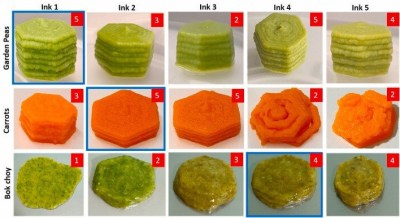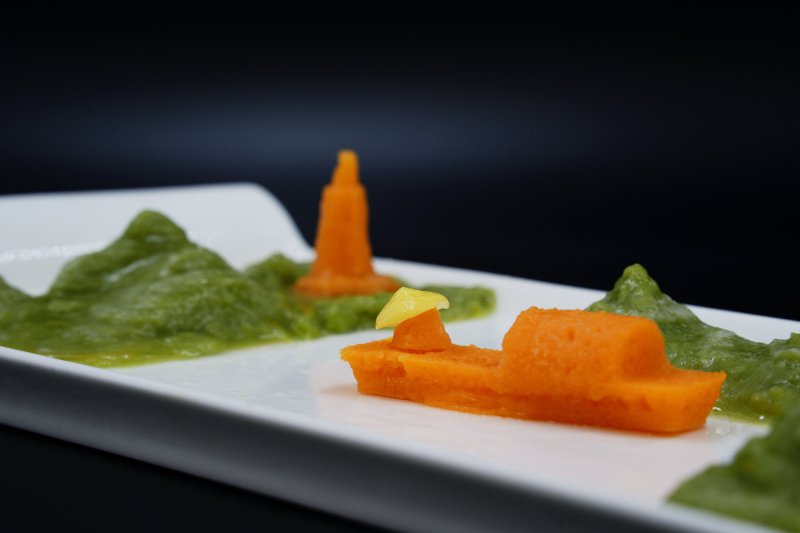Most foods when pureed become pretty unappetizing to look at. For that reason, patients who have trouble swallowing are often given pureed food that’s been molded into fun shapes to make it more appealing. The problem with molding food is that it’s labor-intensive, time-consuming, and the resulting edible toys require a lot of storage space.
 When 3D printing came along, it was poised to solve the problem, but in the quest to make foods printable, they became even worse. Printable food paste typically starts with dehydrated and/or freeze-dried vegetables, and then hydrocolloids like xanthan gum and locust bean gum are added so the paste holds together after extrusion. Unfortunately, these additives are a big step backward; they change the texture for the worse, and make the food smell and taste bad, too.
When 3D printing came along, it was poised to solve the problem, but in the quest to make foods printable, they became even worse. Printable food paste typically starts with dehydrated and/or freeze-dried vegetables, and then hydrocolloids like xanthan gum and locust bean gum are added so the paste holds together after extrusion. Unfortunately, these additives are a big step backward; they change the texture for the worse, and make the food smell and taste bad, too.
The solution is one of those things that sounds obvious in hindsight: some researchers in Singapore tried using fresh and frozen foods instead of freeze-dried, and figured out the minimum amount of hydrocolloids they could get away with for a given food. In their research they categorized all the feasible foods this way. Some vegetables like garden peas which have higher starch and lower water percentages don’t need any hydrocolloids to be printable. As the starch level falls and water rises, more hydrocolloids are needed. So carrots can get away with using just one type of hydrocolloid, while things like bok choy need two types to print effectively. Even so, results of the study show that fresh vegetable printing calls for far less than their powdered counterparts to the extent that it no longer affects the taste of the end product.
The researchers envision a future where every hospital and elder care facility has a food printer to churn out carrot boats and spinach skylines on demand. We think this tasty development is totally awesome — it’s just too bad the carrot boats don’t look more like Benchy.
In the mood for printed food? Our own [Tom Nardi] sampled the menu of additive edibles a while back.
Thanks for the tantalizing tip, [Qes]!

















Is that supposed to be a little guy in a coolie hat? Because if there’s a man in the boat most people will starve before they find it.
Could the 3D food printer nozzle be connected intravenously? Or perhaps with PEG?
Next up, food printer combined with laser cutter.
Laser pizza cutter has already been done. Waterjet too I think.
Here’s a waterjet pastry cutter, I also like the clever mechanism for moving the tray: https://youtu.be/EOOtx4T7OcA
Why not squares like Solyent products including green, or round like carrot slices? Hex-e-gone, yum!
Penrose Tile Pizza
Just stick it in a pouch or tube, I’ll pretend I’m an astronaut.
How about putting some gluten into the food to firm it up? Unless you have celiac disease (or are a food weenie) it should be fine.
The main drawback there is the aforementioned food fetishists would scream blue murder. They don’t want it, so no one else should be allows to have it either.
Celiacs *can’t have* gluten. It causes their immune system to attack their intestines, causing permanent damage. It’s painful and embarrassing.
While I may want nothing more than to be able to eat like a normal human, I encourage you to have a delicious beer and normal pizza in my place. One of us should be able to enjoy good food.
Have you looked into “fecal transplant”? Some people with gluten issues have had good results from getting their intestines colonized with a healthy mix of the right sorts of bacteria. It’s also been effective in some people with Chron’s, IBS, or lactose intolerance. From what I’ve read the most effective method is starting with the saline laxative as used for a full colonoscopy then using an endoscope to deposit the “donor material” throughout the entire colon, and to swallow a lot of capsules that are made to not dissolve until they get down into the small intestine.
When it works, the entire intestinal system gets a full load of good, healthy bacteria that are right to digest a proper omnivore diet.
But as yet (AFAIK) the only use the FDA has approved for fecal transplant is as a last ditch effort against clostridium difficile, after the intestinal flora have been nuclear bombed by all the strongest antibiotics available. Why not try the non-chemical, natural treatment first?
No but I’ve seen the south park episode
“A common household turkey baster. An item that most people use once a year and then shove back into the drawer until next Thanksgiving .”
I don’t know the exact specifics (some people don’t like to go into details about their poo!) but a friend had what sounds like IBS. Digestive discomfort, random diarrhoea etc. After all the usual checks for Celiac, Chron’s, allergies etc, he started a different treatment (under the guidance of a real doctor!) First he went on a really restrictive diet to try to starve out the “bad” bacteria… again, I don’t have all the details but fat and carbs were heavily reduced. It was a very bland couple of months.
The next step was to add in the “good” bacteria. In his case it was E. coli that had been cultured from, I want to say WW1, but it might even have been the Crimean War…. the point was that a culture had been taken from one unusual patient during some horrific unhygienic war who didn’t get dysentery. That strain of E. Coli has been passed along the years.
Yes, this in an anecdote, not data. No, I don’t have all the details. But the recipient is a scientist and not prone to fad diets or “this one weird trick to fix IBS, doctors hate him.”
Anyway, something to look into if you suffer from digestive issues and it *isn’t* a proper allergy or autoimmune disorder.
Here we have AwD and Gregg nicely illustrating the two extremes of attitude.
AwD – it’s not always about you, deal with it.
Gregg -Coeliac disease is a thing, look it up.
AwD says: “Celiacs *can’t have* gluten.”
I didn’t say anything about Celiac disease or the people who suffer from it…
Right? It’s just the crazy “fetishists”, like how diabetics have outlawed sugar, and flour is actually illegal…
Was just thinking about dehydrating or freeze drying, though isn’t so pertinent for the chokeless user requirement. I guess you can even make another dosage form that might be easier to dose with… uhmmm… cocoa butter methods come to mind?